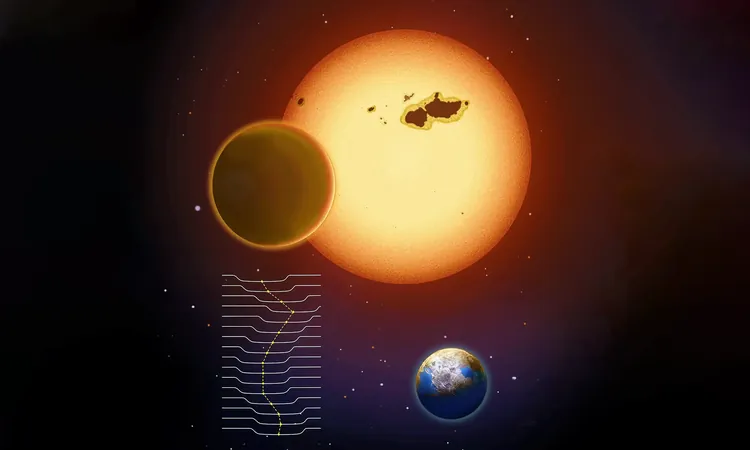
Exciting Discovery: Massive 'Super-Earth' Found in Habitable Zone Could Host Life
2025-06-07
Author: Wei Ling
In an extraordinary breakthrough, scientists have discovered a colossal 'super-Earth' named Kepler-725c, nestled comfortably in the habitable zone of its star, potentially opening doors to the search for extraterrestrial life.
For years, astronomers have been on a relentless quest, peering into the vast expanse of the cosmos for faint signals of distant planets that might host life. Despite advancements in telescope technology, many of these smaller, Earth-like planets remain hidden, often evading traditional detection methods due to their subtle signals and transient alignments.
A Groundbreaking Method for Discovery
Leilei Sun, leading the research team from the Yunnan Observatories of the Chinese Academy of Sciences, spearheaded the identification of Kepler-725c through an innovative approach that bypasses common limitations of exoplanet detection, typically reliant on transit and radial velocity observations.
How Do We Find Exoplanets?
Planets outside our solar system, known as exoplanets, can be detected through various techniques. The transit method, for instance, involves monitoring the slight dimming of a star's brightness when a planet crosses in front of it. Larger planets like Kepler-725c are easier to track due to their frequent stellar crossings. However, smaller planets tend to elude detection due to their longer orbits and less favorable alignments.
The Allure of Kepler-725c
Kepler-725c, measuring up to ten times the mass of Earth, has captured the attention of researchers eager to understand the formation and characteristics of such worlds. The size of a planet significantly influences its environment—from terrain types to potential water sources, making it a prime candidate for habitability studies.
Potential Habitability on the Horizon
This discovery also highlights the effectiveness of the transit timing variation (TTV) method, which tracks the gravitational effects of one planet on another to uncover hidden worlds. Remarkably, Kepler-725c was detected through its gravitational interaction with the nearby warm Jupiter, Kepler-725b.
Located approximately 2,472 light-years from Earth and orbiting a G9V star every 207.5 days, Kepler-725c spends part of its orbit within a habitable zone, receiving about 1.4 times the solar radiation Earth does. Its orbital distance of around 0.674 AU suggests it could experience moderate temperatures, though many factors will ultimately determine its habitability.
The Future of Planetary Exploration
This discovery comes at an exciting time, as global space agencies prepare to launch missions aimed at uncovering smaller planets around Sun-like stars. Initiatives like Europe's PLATO are set to enhance our understanding of these elusive worlds.
By utilizing TTV techniques, researchers believe they can uncover a trove of small, long-orbiting planets that traditional methods might overlook, further refining our search for Earth-like conditions across the galaxy.
Searching for Life in the Cosmos
While the detection of Kepler-725c is groundbreaking, confirming its potential to support life remains a slow, complex endeavor. We still crave direct imaging or atmospheric data to establish whether the planet has essential elements for life, such as water and a stable surface.
A Collaborative Effort
This remarkable achievement was the result of collaboration among scientists from various institutions, including Yunnan Observatories, Hamburg Observatory, and the Nanjing Institute of Astronomical Optics and Technology. Their work reflects a burgeoning global interest in unraveling the mysteries of planetary systems and examining subtle signals that indicate the presence of hidden worlds.
Published in 'Nature Astronomy,' this study heralds a new chapter in our quest to uncover life beyond Earth—reinforcing the notion that even the faintest signals can lead us to unimaginable discoveries in the universe.

 Brasil (PT)
Brasil (PT)
 Canada (EN)
Canada (EN)
 Chile (ES)
Chile (ES)
 Česko (CS)
Česko (CS)
 대한민국 (KO)
대한민국 (KO)
 España (ES)
España (ES)
 France (FR)
France (FR)
 Hong Kong (EN)
Hong Kong (EN)
 Italia (IT)
Italia (IT)
 日本 (JA)
日本 (JA)
 Magyarország (HU)
Magyarország (HU)
 Norge (NO)
Norge (NO)
 Polska (PL)
Polska (PL)
 Schweiz (DE)
Schweiz (DE)
 Singapore (EN)
Singapore (EN)
 Sverige (SV)
Sverige (SV)
 Suomi (FI)
Suomi (FI)
 Türkiye (TR)
Türkiye (TR)
 الإمارات العربية المتحدة (AR)
الإمارات العربية المتحدة (AR)